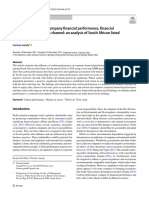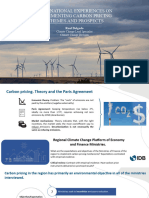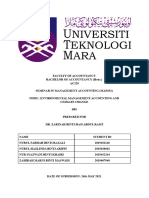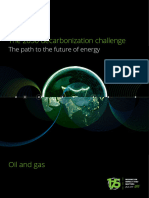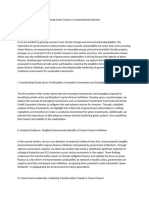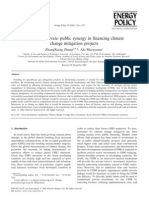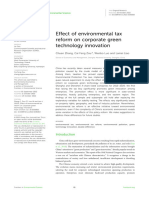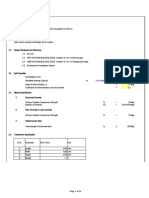TC Malay 4
TC Malay 4
Uploaded by
Endang MariyaniCopyright:
Available Formats
TC Malay 4
TC Malay 4
Uploaded by
Endang MariyaniCopyright
Available Formats
Share this document
Did you find this document useful?
Is this content inappropriate?
Copyright:
Available Formats
TC Malay 4
TC Malay 4
Uploaded by
Endang MariyaniCopyright:
Available Formats
COMPENDIUM by paperASIA
Unveiling Perspectives on Carbon Tax in the
Carbon Emissions Industry
Zaimah Zainol Ariffin1*, Natrah Saad1, Syed Mahathir Syed Mustaphanin2
1
Tunku Puteri Intan Safinaz School of Accountancy, College of Business, Universiti Utara Malaysia, 06010 UUM
Sintok, Kedah, Malaysia
2
Tax Policy Department, Inland Revenue Board of Malaysia, 63000 Cyberjaya, Selangor, Malaysia
*Corresponding author email: zaimah@uum.edu.my
ABSTRACT
The pressure of climate action becomes more crucial, especially to achieve the goals outlined in the Paris
Agreement. In the Paris Agreement, Malaysia has committed to reducing greenhouse gas emissions across the
economy by 45% in 2030. Malaysia has taken proper action to ensure the reduction of carbon emissions. Still, it
only focuses on tax incentives and motivations toward a clean environment without involving tax penalties for the
emitters. Policymakers worldwide are now changing to tax-based policies to lessen carbon emissions. Malaysia is
also expected to implement the carbon tax soon. This study aims to determine Malaysia's crucial carbon emission
sector and investigate the perception of implementing a carbon tax in Malaysia. This study uses desk research
and questionnaires to collect data from the industry, the Inland Revenue Board of Malaysia, and the public. This
study has successfully identified key sectors responsible for significant carbon emissions and gathered respondents'
perceptions towards implementing a carbon tax. The implications of the study are also highlighted.
KEYWORDS: Greenhouse gas emissions, Carbon emissions, Carbon tax
Received March 26, 2024; Revised April 8, 2024; Accepted April 27, 2024
Doi: https://doi.org/10.59953/paperasia.v40i3b.108
1. INTRODUCTION of cleaner technologies, and fosters responsible
environmental stewardship.
Implementing a global carbon tax has become
increasingly imperative in the collective effort to Malaysia adopts an incentive approach rather than
combat cl i mate change. Count r ies wo r ldw ide imposing taxes to tackle greenhouse gas emissions. The
recognise the significance of imposing a carbon tax former involves encouraging environmentally friendly
as a key policy tool to curb carbon emissions. Adopting practices through positive reinforcements rather than
such measures on a global scale is crucial for creating imposing direct financial penalties. The government
a level playing field and ensuring that businesses provides several incentives, for example, the Green
and individuals across borders contribute equitably Investment Tax Allowance (GITA), which g rants
to reducing emissions. International cooperation in businesses tax allowances for capital expenditures
implementing carbon taxes is essential to address the related to environmentally friendly technology and
transboundary nature of environmental challenges equipment. Additionally, income generated from
and promote a more sustainable and resilient global qualifying green activities may be exempted from
economy. As nations work towards common goals in income tax, incentivising participation in eco-friendly
mitigating climate change, the worldwide carbon tax initiatives. Accelerated Capital Allowance (ACA) allows
implementation is pivotal in fostering a greener and businesses investing in energy-efficient machinery or
more sustainable future. equipment to benefit from accumulated depreciation
for tax purposes.
Carbon tax holds significant importance in addressing
environmental concerns and mitigating climate Furthermore, the incentive focuses on renewable
change. Incentivising businesses and individuals to energy, reflecting specific incentives for projects such
reduce their carbon emissions is crucial by imposing as solar or wind power. Additionally, public awareness
a financial cost on releasing greenhouse gases. campaigns and educational initiatives are employed to
This economic instrument is essential for promoting inform businesses and the public about the advantages
sustainable practices and fostering a transition towards of embracing eco-friendly practices and taking
a low-carbon economy. A carbon tax helps combat advantage of available incentives. Finally, investment
climate change, encourages the development in technological innovation is a crucial aspect of this
paperASIA 40 (3b): 2024 12
COMPENDIUM by paperASIA
approach, with the government supporting research The environmental tax law favours tax incentives rather
and development in green technologies to stimulate than tax penalties in Malaysia. For example, in 2014,
economic growth while reducing emissions. two green tax incentives were introduced - Green
Investment Tax Allowance (GITA) and Green Income
A carbon tax is a form of carbon pricing that aims to Tax Exemption (GITE). Under these schemes, various
reduce greenhouse gas emissions by taxing the carbon accelerated allowances and exemptions were given
content of fossil fuels. The primary goal is to incentivise to industries securing environmentally friendly assets or
businesses and individuals to reduce their carbon engaging in such activities. However, few companies
footprint and transition towards cleaner and more have utilised these incentives (Saad & Ariffin, 2019).
sustainable energy sources. Governments can generate When probed further on the underlying reasons,
revenue through carbon taxes, which can be used to some commented that they were unaware of the
fund renewable energy projects, climate adaptation incentives. Meanwhile, others claimed that they had
initiatives, or other environmentally beneficial programs. limited knowledge of the conditions and procedures
This revenue can also offset potential economic impacts to apply (Saad & Ariffin, 2019). This situation indicates
on vulnerable populations. that the move by the government has not yet been
fruitful. Following that, in 2020, the Malaysian Green
A carbon tax can be a valuable tool in the fight against Technology and Climate Change Centre (MGTC)
climate change. It should be part of a broader strategy designed a few frameworks to motivate local councils
considering economic impacts, technological feasibility, to improve the administration of climate change in the
and a country's overall policy objectives. Engaging with country. Furthermore, Ariffin et al. (2023) suggested that
stakeholders and carefully designing the policy are it is important to understand the factors contributing to
crucial steps in determining the appropriateness and the acceptance of green tax policy to strengthen the
effectiveness of a carbon tax for Malaysia. green growth environment and enhance awareness,
thus creating a shared responsibility.
The decision to implement a carbon tax in Malaysia
i s a co m p l ex p ro ce s s t h at i nvo l ve s a ca ref u l Policymakers worldwide are changing to tax-based
balance between environmental goals, economic policies to lessen carbon emissions. The governments
considerations, and societal acceptance. It requires and policymakers decide to turn to tax policies with the
a thorough understanding of the country's emission assistance of experts, such as economists, researchers,
profile of various sectors in Malaysia, public awareness industries, and financial sectors. The decision is always
of emissions, and the potential impacts of implementing based on the struggle between competing interests
a carbon tax on numerous sectors of the economy. This lobbying with different ideologies and roles. The biggest
study seeks to identify the crucial sectors contributing hurdle in introducing carbon tax is perhaps due to the
to carbon emissions in Malaysia and examines public existing carbon pricing schemes that are too weak
perceptions regarding implementing a carbon tax in and lack support from the industries and the public.
the country. For instance, Cullenward and Victor (2020) argued
that the success of pricing emissions needs necessary
2. LITERATURE REVIEW transformation tailored to each sector. Following the
move of developed and other developing countries,
Pr ior studies have made significant evaluations Malaysia is also expected to implement the carbon
on mechanisms adopted by countries to reduce tax before long.
environmental pollution, for example, studies in
transpor tation (Shen & Feng, 2020), ecological Each country's government introduced a carbon tax
(Dresner et al., 2006), and energy sectors (Elahi et al., to reduce carbon emissions and mitigate the impact
2019). The United Nations (UN) agrees that a carbon of climate change. The effectiveness of a carbon tax
tax is one approach to reducing carbon emissions, in reducing carbon emissions is still in question. Limited
providing a healthier environment, and improving the studies showing the significant effect of introducing the
economy. Finland was the first country to introduce a carbon tax and reducing total emissions do not imply
carbon tax (in 1990), followed by Sweden, Denmark, that the tax has not reduced emissions. Further studies
the Netherlands, Slovenia, Germany, and the United should be conducted, especially involving countries
Kingdom. As in Southeast Asia, Singapore is the first that intend to introduce carbon taxes as a new tax
countr y to implement a carbon tax. The countr y policy.
introduced a comprehensive form of carbon tax, a
broad-based price signal to urge companies to reduce Studies on the efficacy of carbon-pricing policy on
their emissions in 2019. The tax is applied uniformly to all emissions specifically concentrate on the specific
sectors, including energy-intensive and trade-exposed sectors, such as energy, transport, and ecology. The
sectors, to reduce emissions and create green growth International Energy Agency-IEA (2019) reports that
environments. carbon dioxide emissions from the transport sector
13 paperASIA 40 (3b): 2024
COMPENDIUM by paperASIA
in Malaysia accounted for 28.8% of the total sectors, in the transport sector, and using high-quality public
greater than the average global transport emissions of transport, particularly in urban areas, for sustainable
24.5%. Solaymani (2022) concludes that transportation urban development.
significantly contributes to carbon dioxide emissions in
Malaysia. Solaymani's study shows that a 1% increase in 3. METHODOLOGY
gross domestic product (GDP) per worker raises 0.63%
of carbon emissions in this sector. He added that the This study aims to determine the crucial carbon
cause of emissions from transportation involves various emission sector and investigate the perception of
forms of pollution that create diseases and irreparable the implementation of a carbon tax on the green
environmental damage. environment in Malaysia. In gaining an answer to the
first objective, secondary data and information about
Prior studies have shown mixed findings regarding the the level of carbon emissions based on sectors in
effectiveness of carbon-pricing policy and emissions. Malaysia were collected from the emissions reported
Studies by Eskander and Fankhauser (2020), Metcalf by several environmental institutions: the Malaysian
and Stock (2020), and Rafaty et al. (2020) found that Green Technology and Climate Change Corporation,
carbon pricing has a marginal reduction in emissions. Trading Economics, The World Bank, and Our World in
They consistently agreed that the intervention of a Data. In achieving an answer to the second objective,
carbon-pricing policy is set too low to achieve significant a survey was carried out to seek perspectives from
reductions in aggregate emissions. Furthermore, Best the industry, policymakers, and the public (individual
et al. (2020) found some small reductions in emissions taxpayers) concerning the implementation of a carbon
in relation to carbon pricing. Xiong and Hassan (2023) tax in Malaysia. The respondents from the industry were
reported that energy tax exerts a positive influence from the manufacturing companies and members of
on reducing carbon emissions and is expected to the Federation of Malaysian Manufacturers (FMM).
yield beneficial long-term effects on greenhouse gas The respondents representing policymakers were the
emissions. Inland Revenue Board of Malaysia (IRBM) officers of
the Tax Policy Department, IRBM Cyberjaya. Officers
According to Chen et al. (2022), a carbon tax is a tax from the Tax Policy Department of IRBM are the best-
imposed on fossil fuels (for example, oil, coal, and chosen respondents because the department is closely
natural gas) based on the proportion of their carbon involved with the environmental and climate change
content or carbon emissions. Introducing a carbon tax mechanism, SDG 13, in Malaysia. The respondents
will increase the prices of energy and related goods and representing the public were individual taxpayers from
services. Under a carbon tax, the government sets a Kuala Lumpur and Selangor.
price that emitters must pay for each ton of greenhouse
gas emissions. Businesses and consumers will take steps, The survey was divided into several sections. In Section
such as switching fuels or adopting new technologies, 1, the respondents were asked about their overall
to reduce their emissions to avoid paying taxes. perception of carbon emissions, including the level
of concern, the responsible agency, and the green
Andersson's (2019) studies on the introduction of a technology engaged by the respondents. In Section
carbon tax in Sweden found a significant effect on 2, respondents were asked about their acceptance of
vehicle emission reduction. Farmer et al. (2019) point implementing a carbon tax. The questions asked were
out that the current carbon tax rates are too low and about the positive and negative effects of carbon taxes.
conclude that a carbon tax alone is insufficient to In this section, the questions were to frame their consent
lower aggregate emissions. They added that other on the implementation of a carbon tax in reducing
interventions should be in place, such as technology- emissions. Finally, Section 3 sought the respondents’
pushing policies that could target the crucial sectors. demographic background. In addition, the section
sought their agreement on the implementation of a
Previous studies have also measured other effects of carbon tax in Malaysia. Furthermore, the respondents
carbon tax. Rivers and Schaufele (2015), Lawley and were asked which industry segment needed a carbon
Thivierge (2016), and Antweiler and Gulati (2016) found tax. Before distribution, the questionnaires were sent to
that the carbon tax led to a reduction in gasoline the experts in the field for validation.
demand. Saberian (2018) found that introducing a
carbon tax led consumers to switch to diesel cars, thus The questionnaire was adapted from previous relevant
increasing local pollution. Carbon tax is not always the studies on carbon taxation, such as Goh and Matthew
solution to reducing carbon emissions and perhaps may (2021) and Unni et al. (2022). However, some modifications
lead to other consequences. Solaymani (2022) instead were made to fit the objectives of this study. Content
contends that in reducing emissions, policymakers need validity of the items was conducted to ensure that the
to pay more attention to improving energy efficiency, respondents understood the questions. The data were
using low-carbon technologies and electrification collected within three months. Questionnaires were
paperASIA 40 (3b): 2024 14
COMPENDIUM by paperASIA
distributed through emails to every company identified of this ranking highlights its significant contribution to
from the FMM list, tax authorities, and individual global carbon emissions. Understanding Malaysia's
taxpayers. After two weeks, follow-ups were made, carbon dioxide emissions in the context of global
and the respondents were given an additional two emissions helps assess its environmental impact and its
weeks to complete the questionnaire. The second and role in addressing climate change concerns. The IPCC's
third follow-ups were made after the end of two weeks fifth assessment report (AR5) analysed the impacts of
from the last follow-up. After the third follow-up, the climate change, denoted that "climate change has
researchers assumed that the respondents did not wish a range of potential ecological, physical, and health
to participate if they did not return the questionnaire impacts, including extreme weather events (such as
after another two weeks, on 15 September 2023. floods, droughts, storms, and heatwaves), sea-level
rise, altered crop growth, and disrupted water systems.
4. RESULTS AND DISCUSSION Carbon dioxide emissions account for the largest share
of greenhouse gases which are associated with climate
This section presents the results and discussion in change and global warming."
alignment with the study’s objectives. The first objective
of this study is to ascertain Malaysia’s crucial carbon
emission sector. The second objective of this study Table 1: World Ranking of Carbon Dioxide Emissions – 2021
involves an exploration of perceptions regarding the
implementation of a carbon tax in Malaysia.
4.1 Crucial Carbon Emission Sector in Malaysia
The result is based on desktop research that collects
information on crucial carbon emission sectors in
Malaysia. Table 1 and Table 2 show the ranking of
carbon dioxide emissions in 2021 for the world and
Asia, respectively. The reports were gathered from
the Intergovernmental Panel on Climate Change
(IPCC) assessment. IPCC was established in 1988, to
deliver information about climate change to nations
wor ldwide. The IPCC was for med by the Wor ld
Meteorological Organization (WMO) and the United
Nations Environment Programme (UNEP), which provide Table 2: Asia Ranking of Carbon Dioxide Emissions - 2021
the latest scientific information about climate change.
In Table 1, the data for carbon dioxide emissions
are calculated and reported based on the unit of
measurement in KT (kiloton). The measurement of
carbon dioxide includes gases from burning fossil
fuels and cement manufacture but does not include
emissions from land use such as deforestation. Table
1 shows Malaysia ranked number 13 in producing
carbon dioxide globally in 2021, after Thailand. Malaysia
emitted 251,555 KT or 2% of carbon dioxide in 2021, the
largest emitter being China.
Table 2 provides data on the ranking of carbon dioxide
emissions in Asian countries. The table presents data Figure 1 presents Malaysia's carbon dioxide emissions
on carbon dioxide emissions in kilotons (KT) for the top pattern from 2013 to 2022. The data reveals notable
15 Asian countries, focusing on Malaysia's position in fluctuations in carbon dioxide emissions over the
relation to other nations. The 15 Asia countries listed are timeframe, with the lowest recorded emission occurring
ranked according to their carbon dioxide emissions. in 2013 at 237,500 KT, compared to the peak emission
Malaysia's carbon dioxide emissions rank fifth on the in 2 019, reaching 266,0 0 0 K T. Malaysia emitted
list with 251,555 kilotons. This data highlights Malaysia's approximately 251,000 KT of carbon dioxide annually
position relative to other countries regarding carbon throughout the period. While these figures offer insights
dioxide emissions. While Malaysia's emissions are into the general trends of carbon dioxide emissions, they
significant, they are lower than those of countries like highlight the necessity for further inquiry to ascertain the
China, Saudi Arabia, and Vietnam but higher than many specific sectors within Malaysia contributing significantly
others listed in the table. Malaysia's position in the middle to carbon dioxide emissions.
15 paperASIA 40 (3b): 2024
COMPENDIUM by paperASIA
By identifying and understanding the primary sources of greenhouse gas and carbon emissions globally.
of carbon dioxide emissions, policymakers and Figure 2 presents data on carbon emissions across
stakeholders can formulate targeted strategies and various sectors over ten years in Malaysia.
inter ventions to mitigate environmental impacts
and foster sustainable development practices. Figure 2 shows the pattern of carbon dioxide emissions
Consequently, in-depth investigations into sectoral by sector in Malaysia from 2000 to 2019. Analysis of the
emission patterns are imperative for informing effective data reveals distinct trends in emissions for each sector.
policy frameworks and promoting environmental Carbon emissions from the electricity and heat sector
stewardship within Malaysia. show a consistent increase, rising from 50 million tonnes
in 2000 to 150 million tonnes in 2019, with occasional
Further analysis may consider factors such as sectors of fluctuations. Similarly, emissions from the transport
industrial activities and energy consumption to give a sector display a steady upward trend, increasing from
better understanding of the context and implications of 35 million tonnes in 2000 to over 60 million tonnes over
the emission levels. Our World in Data provided a report the same period.
Figure 1: Carbon Dioxide Emissions in Malaysia, 2013 – 2022.
Figure 2: Carbon Dioxide Emissions by Sector in Malaysia, 2000 – 2019
paperASIA 40 (3b): 2024 16
COMPENDIUM by paperASIA
In contrast, carbon emissions from industry, fugitive for designing effective policy frameworks and ensuring
emissions, buildings, and other fuel combustion sectors their acceptance and compliance. Therefore, further
remain relatively stable, fluctuating bet ween 10 investigations into the perception of implementing a
million and 15 million tonnes throughout the decade, carbon tax in Malaysia are warranted.
indicating a stable, increasing trend. Emissions from
the manufacturing and construction sectors gradually 4.2 Perception Towards Implementing a Carbon Tax in
rise, increasing from 20 million to 30 million tonnes by Malaysia
2019, with incremental growth and variations. This land- This section presents the outcomes and insights
use change and forestry category exhibit remarkable derived from assessing the perception towards the
fluctuations, including negative emissions in some years, implementation of a carbon tax in Malaysia.
possibly due to carbon sequestration activities such as
afforestation or reforestation. However, the trend seems Table 3 shows the categories of respondents in the
to fluctuate, with an overall rise from negative values in study. The study comprised 250 respondents (n= 250),
2011 to positive ones in 2019. of which 100 respondents (40%) were from industries,
100 respondents were from the IRBM (40%), and 50
In summary, while the electricity and heat, transport, respondents (20%) were from the public (individual
manufacturing, and construction sectors experience taxpayers).
consistent increases in carbon emissions, industry,
fugitive emissions, buildings, and other fuel combustion Table 3: Category of Respondents
sectors maintain relatively steady patterns. The
categor y of land-use change and forestr y shows
notable fluctuations, reflecting the complexity of factors
involved in carbon emission activities. The crucial
sectors that highly contributed to carbon emissions
comprise of electricity and heat, land-use change
Table 4 elaborates more on sectors in the industry. The
and forestry, transportation, and manufacturing and
table provides a breakdown of different categories of
construction. Understanding the emissions of these
industry, along with their corresponding frequencies and
sectors is necessary for crafting strategies and policy
percentages. Electrical and Electronics have the highest
interventions to reduce the overall carbon emissions.
percentage among the various categories listed,
Understanding these sectors is vital for developing and
representing 11.2% of the total companies. Following
implementing effective climate policies and mitigation
closely, Food, Beverage & Tobacco account for 7.2% of
strategies. Identifying these sectors allows policymakers
the companies. Additionally, Machinery & Equipment
to target interventions and regulations where they are
and Agriculture each account for 4.4%, followed by
most needed to reduce carbon emissions effectively.
Chemical with 4.0%.
One such strategy involves the implementation of
a carbon tax, which imposes a fee on the carbon Table 4: Sectors of the Industry
content of fossil fuels or the carbon dioxide emissions
generated by industries, transportation, and other
activities. By internalizing carbon emissions' social and
environmental costs, carbon taxes incentivize businesses
and individuals to reduce their carbon footprint and
transition towards cleaner and more sustainable
alternatives.
Integrating carbon tax policies into broader frameworks of
environmental regulation and sustainable development
initiatives represents a holistic approach to combating
climate change. By combining carbon tax with tax
incentives such as investments in renewable energy,
energy efficiency measures, technological innovation,
and public awareness campaigns, policymakers can
create synergistic effects that accelerate the transition
to a low-carbon economy while fostering economic Table 5 shows that the majority of respondents (60.8%)
growth and social equity. However, the successful perceive carbon emissions in Malaysia to be moderate
implementation of carbon tax policies hinges on public in severity. However, a significant portion, 33.2%,
acceptance and support. Understanding stakeholders' view carbon emissions as highly severe. Only a small
perceptions towards carbon taxation, including percentage, 6.0%, considers the severity of carbon
businesses, policymakers, and the public, is essential emissions in Malaysia to be low.
17 paperASIA 40 (3b): 2024
COMPENDIUM by paperASIA
of recognising and addressing varying levels of concern,
Table 5: How severe would you say the carbon emission in Malaysia is? understanding, and engaging with carbon emissions
to mitigate their impact and effectively work towards
a sustainable future.
Table 7 provides insights into respondents' perspectives
regarding the primary entity responsible for reducing
carbon emissions. A notable portion of respondents,
Concerning the respondents' views towards the existing comprising 24.8%, believe the government should
condition of carbon emissions, Table 6 shows that the bear primary responsibility. This viewpoint reflects an
majority, constituting 56.8%, are "concerned" about expectation for governmental bodies to enact policies,
the issue. Following closely, 22.8% of respondents feel regulations, and initiatives to mitigate carbon emissions
“strongly concerned” about the existing condition and address environmental concerns. In contrast,
of carbon emissions. A notable portion, 16.8%, are a smaller proportion of respondents (8.0%) attribute
uncertain regarding their level of concern, while only primary responsibility to ‘citizens.’ This perspective
3.2% of respondents were "not concerned." Lastly and suggests that individuals’ actions, for example, engaging
surprisingly, one respondent expressed, “I do not care in sustainable practices and reducing personal carbon
at all" about carbon emissions. In summary, the findings footprints, are pivotal in combating climate change.
underscore respondents’ varying levels of concern However, the majority of respondents (67.2%) assert
about carbon emissions. that ‘Industry’ should primarily be responsible for
reducing carbon emissions. This viewpoint underscores
Table 6: State your level of concern about the existing condition of the significance of industrial practices, technological
carbon emissions
innovations, and corporate sustainability efforts in
driving substantial reductions in carbon emissions and
promoting environmental stewardship.
Table 7: Who do you think should be primarily responsible for reducing
carbon emissions?
In detail, a substantial majority (56.8%) expressed that
they are “concerned” about the existing condition of
carbon emissions. This finding suggests a significant
recognition among respondents of the importance
The disparity in responses highlights differing perceptions
and impact of carbon emissions on environmental
regarding the roles and responsibilities of governmental
and societal well-being. Furthermore, the fact that
institutions, citizens, and industries in addressing the
a large number of respondents (22.8%) feel “strongly
pressing issue of carbon emissions. It also underscores the
concerned” indicates a heightened sense of urgency
complexity of managing climate change and the need
and perhaps a deeper understanding of the potential
for coordinated efforts among multiple stakeholders,
consequences of unchecked carbon emissions.
including government agencies, businesses, and
In contrast, a notable proportion of respondents,
individuals, to achieve meaningful progress towards
comprising 16.8%, expressed uncertainty about their
sustainability and environmental preservation.
level of concern. This uncertainty may reflect a lack of
clarity or information about the issue among certain
Table 8 presents data regarding respondents' preferred
segments of the respondent population. Additionally,
methods for acquiring knowledge related to carbon
the finding that only 3.2% of respondents stated they
emissions, climate change, and associated protective
were “not concerned” suggests that most respondents
measures. According to the findings, the internet
acknowledge the significance of addressing carbon
emerges as the overwhelmingly favoured medium,
emissions, albeit to varying degrees.
with 92.8% of respondents expressing a preference for
online sources. In contrast, traditional media platforms
Lastly, the mere presence of an individual who stated they
such as television and radio found significantly less
‘Do not care at all’ about carbon emissions underscores
interest, accounting for only 5.2% of respondents. None
the respondent group's diversity of perspectives and
of the respondents preferred obtaining information from
attitudes. This bizarre perspective may highlight the
newspapers, friends, or other sources. Furthermore, a
need for further education, awareness-raising, and
small minority, comprising 2.0% of respondents, stated
advocacy efforts to foster greater understanding and
that they do not utilise any specific method to acquire
engagement with the issue of carbon emissions across
knowledge in this domain. Overall, the data underscores
society. Overall, the analysis emphasises the importance
the paramount importance of digital platforms in
paperASIA 40 (3b): 2024 18
COMPENDIUM by paperASIA
disseminating information about climate change, green technology. This breakdown highlights the
highlighting a diminishing reliance on traditional media landscape of green technologies engagements and
channels for such insights. emphasises the significant effort of paperless solutions
among respondents.
Table 8: What is your most favourite way to obtain knowledge about
carbon emissions, climate change, and related protective measures? Table 10: Which green technology have you or your company been
involved in?
Table 9 presents the frequency distribution and
corresponding percentages of responses to the query
Table 11 portrays respondents' perceptions regarding
regarding the potential implementation of a carbon
which sectors should implement carbon taxes, reflecting
tax in Malaysia. Out of the total 250 responses analysed,
varying degrees of necessity across different segments.
the majority, 189 respondents (75.6%), agreed with
Each respondent may select more than one answer
implementing a carbon tax. Conversely, 61 respondents
of which sector needs carbon tax. Among the sectors
(24.4%) opposed the idea of implementing such a
listed, industrial processes receive the highest level of
tax. The finding provides an overview of respondents'
necessity, with 110 respondents advocating for carbon
positions regarding the matter, demonstrating that a
taxes in this domain, constituting 31.9% of the total
substantial proportion supports the introduction of a
responses. The evidence suggests a widespread belief
carbon tax, while a significant minority hold contrasting
among respondents regarding the significance of
viewpoints. In summary, the table highlights that the
regulating emissions from industrial activities. Electricity,
majority of respondents agree with the implementation
heat, and energy follow closely, with 107 respondents
of a carbon tax within the Malaysian context, indicating
(31.0%) advocating for carbon taxation within this
that carbon taxation is viewed as an important method
sector, reflecting the acknowledgment of its significant
and mechanism for protecting and sustaining the
contribution to carbon emissions. The manufacturing
environment.
and construction sectors also garner substantial
Table 9: Do you agree the carbon tax should be implemented in attention, with 30 respondents (8.7%) supporting the
Malaysia? implementation of carbon tax measures within these
industries. Transport and agriculture, food, and waste
sectors exhibit comparatively lower levels of perceived
necessity for carbon taxation, with 12 respondents (3.5%)
and 16 respondents (4.6%), respectively.
Table 10 p resents data rega rding respondents' Table 11: Which sector needs a carbon tax?
involvement in various green technologies. Each
respondent may select mo re than one ans wer
(green technology) in which the respondent may
engage. The findings demonstrate that the highest
involvement, that is paperless, leads the efforts with 110
instances, constituting 31.0% of the total engagements.
Solar panels closely follow, with 107 engagements
representing 30.1% of the total. In contrast, wind turbines
and carbon capture and storage exhibit lower levels of Similarly, land use change and forestry sectors show
involvement, with eight instances (2.3%) and 12 instances the least perceived need, with only eight respondents
(3.4%), respectively. Waste-to-energy and rainwater (2.3%) advocating for carbon taxation within this
har vesting technologies demonstrate moderate domain. Moreover, 62 respondents (18.0%) believe that
levels of engagement, with 30 instances (8.5%) and 16 no specific segment requires carbon tax, indicating a
instances (4.5%), respectively. The category labelled divergence of opinion among respondents regarding
'others' accounts for 62 instances, making up 17.5% of the necessity and application of carbon tax policy
the total engagements, reflecting a diverse array of mechanisms. This breakdown illustrates the varying
technologies beyond the listed categories. Finally, a perceptions regarding the sectors that most urgently
minor fraction, ten instances (2.8%), indicates cases need carbon taxation, underscoring the complexity of
where respondents did not engage with any specific addressing carbon emissions across different industries
and domains.
19 paperASIA 40 (3b): 2024
COMPENDIUM by paperASIA
5. CONCLUSION Green tax policy model: towards green growth
environment. PaperASIA, 39 (6b), 1-7. https://
This study has effectively identified the sectors responsible compendiumpaperasia.com/index.php/cpa/
for carbon emissions, emphasizing the need for targeted article/view/47/18
interventions to address climate change. Notably, Best, R., Burke, P. J., &Jotzo, F. (2020) Carbon pricing
sectors related to electricity and heat production, efficacy: cross-country evidence. Environmental
land-use change and forestry activities, transportation, Resource Economics, 77(1):69–94.
manufacturing, and construction emerge as major Chen, Q., Zha, D., &Salman, M. (2022). The influence of
contributors to carbon emissions. Hence, effective carbon tax on CO2 rebound effect and welfare
policies to reduce emissions and foster sustainable in Chinese households. Energy Policy, 168. www.
development must be designed and implemented for elsevier.com/locate/enpol.
these sectors. Cullenward, D. & Victor, D.G. (2020). Making climate
policy work. Law Environment and Development
Based on the identified sectors, policymakers and Journal. http://www.lead-journal.org/content/
stakeholders should prioritize the development and b1702.pdf.
implementation of focused strategies to mitigate Dresner, S., Dunne, L., Clinch, P., & Beuermann, C. (2006).
carbon emissions. In addition to implementing a Social and political responses to ecological tax
carbon tax, the strategy should involve transitioning reform in Europe: an introduction to the special
towards renewable energy sources, improving energy issue. Energy Policy, 34 (8), 895–904. https://doi.
efficiency measures, advocating for sustainable land org/10.1016/j.enpol.2004.08.043.
management practices, and embracing low-carbon Elahi, E., Weijun, C., Jha, S. K., & Zhang, H. (2019).
transportation options. Additionally, investing in cleaner Estimation of Realistic Renewable and Non-
technologies and fostering international collaborations renewable Energy Use Targets for Livestock
are paramount for addressing global climate challenges Production Systems Utilising an Artificial Neural
and advancing sustainable development goals on a Net work Method: A Step towards Livestock
broader scale. By leveraging targeted policies and Sustainability. Energy, 183 (C), 191–204. doi:10.1016/
collaborative efforts, societies can work towards a j.energy.2019.06.084.
greener and more sustainable future while mitigating Eskander, S. M., &Fankhauser, S. (2020) Reduction in
the impacts of climate change. greenhouse gas emissions from national climate
legislation. National Climate Change, 10(8),
This study, which explores perspectives on carbon 750–756.
tax, presents significant evidence supporting the Farmer, J. D., Hepburn, C., Ives, M. C., Hale, T., Wetzer,
acceptance of implementing a carbon tax in Malaysia. T., & Mealy, P. (2019) Sensitive intervention points
This study also reveals a readiness among respondents in the post-carbon transition. Science, 364(6436),
to consider tax policy measures targeting the reduction 132–134.
of carbon emissions. This highlights an opportunity for Goh, I. Z. & Matthew, N. K. (2021). Residents’ Willingness to
policymakers in Malaysia to utilize this support in crafting Pay for a Carbon Tax. Sustainability, 13(18), 10118.
and executing comprehensive environmental policies, https://doi.org/10.3390/ su131810118.
which may involve the implementation of a carbon tax. Intergovernmental Panel on Climate Change (2022).
Climate Change 2022: Impacts, Adaptation and
ACKNOWLEDGEMENT Vulnerability. https://www.ipcc.ch/report/sixth-
assessment-report-working-group-ii/.
We would like to express our gratitude to the Ministry of Lawley, C. & Thivierge, V. (2016). Refining the evidence:
Higher Education (MoHE) of Malaysia for providing us British Columbia’s carbon tax and household
with the Research Generation Grant Scheme 2.0 (S/O gasoline consumption. The Energy Journal, 39(2),
Code: 21424) to carry out this research project, as well https://doi.org/10.5547/01956574.39.2.claw.
as the department of Research Management Centre Metcalf, G. E. & Stock, J. H. (2020). The macroeconomic
at Universiti Utara Malaysia. impact of Europe’s carbon taxes. NBER working
paper (w27488).
REFERENCES Our World in Data. (n.d.). Greenhouse gas emissions by
sector. https://ourworldindata.org/grapher/ghg-
Andersson, J.J. (2019). Carbon taxes and CO2 emissions: emissions-by-sector
Sweden as a case study. American Economic Rafaty, R., Dolphin, G., & Pretis, F. (2020). Carbon pricing
Journal: Economic Policy, 11(4),1-30. and the elasticity of CO2 emissions (p. 341955).
Antweiler, W., & Gulati, S. (2016). Frugal cars or frugal University of Cambridge, Faculty of Economics.
drivers? How carbon and fuel taxes influence the Rivers, N., & Schaufele, B. (2015). Salience of carbon taxes
choice and use of cars. Working Paper. in the gasoline market. Journal of Environmental
Ariffin, Z.Z., Sulaiman, A.J., Bidin, Z. & Jamil, C.Z.M. (2023). Economics Management, 74, 23–36.
paperASIA 40 (3b): 2024 20
COMPENDIUM by paperASIA
Saad, N. & Ariffin, Z.Z. (2019). Implementation of green
tax in Malaysia: An exploratory study. Growth,
6(1), 12-19.
Saberian, S. (2018). The negative effect of the BC carbon
tax on Vancouver air quality: A good climate for
bad air? Working Paper.
Shen, X., & Feng, S. (2020). How public transport
subsidy policies in China affect the average
passenger load factor of a bus line. Research in
Transportation and Business Management, 36,
100526. doi:10.1016/j.rtbm.2020.100526.
Solaymani, S. (2022). CO2 Emissions and the transport
sector in Malaysia. Environmental Economics
and Management ht tps://doi.o rg/10. 3 3 89/
fenvs.2021.774164
The International Energy Agency-IEA Report. (2019).
Global Energy & CO2 Status Report: The latest
trends in energy and emissions in 2018. https://
www.iea.org/reports/global-energy-co2-status-
report-2019.
Trading Economics. (n.d.). CO2 emissions. https://
tradingeconomics.com/country-list/co2-emissions
Trading Economics. (n.d.-b). Malaysia CO2 emissions.
https://tradingeconomics.com/malaysia/co2-
emissions
United Nations Climate Change Annual Report (2019).
https://unfccc.int/sites/default/files/resource/
unfccc_annual_report_2019.pdf.
Unni, B., Tang, N., Cheng, Y.M., Gan, D. & Aik, J. (2022).
Community knowledge, attitude and behaviour
towards indoor air quality: A national cross-
sectional study in Singapore. Environmental
Science and Policy, 136, 348-356.
Xiong, C. and Hassan, M.S. (2023). The implication
of renewable heat policy on reducing
carbon emissions in China: a dynamic CGE
simulation. PaperASIA, 39 (5b), 16-27. https://
compendiumpaperasia.com/index.php/cpa/
article/view/26/13
21 paperASIA 40 (3b): 2024
You might also like
- Ganda2022 Article CarbonPerformanceCompanyFinancNo ratings yetGanda2022 Article CarbonPerformanceCompanyFinanc14 pages
- Taiwan Carbon Fee Measures March 2024 1No ratings yetTaiwan Carbon Fee Measures March 2024 147 pages
- Carbon Management and Emission Tracking: Essential Tools for Net-ZeroFrom EverandCarbon Management and Emission Tracking: Essential Tools for Net-ZeroNo ratings yet
- Punitha Silvarajoo. Malaysia - Low Carbon Development - Towards Achieving Green Growth100% (1)Punitha Silvarajoo. Malaysia - Low Carbon Development - Towards Achieving Green Growth45 pages
- Decarbonization Policy and High-Carbon Enterprise Default Risk Evidence From ChinaNo ratings yetDecarbonization Policy and High-Carbon Enterprise Default Risk Evidence From China11 pages
- APEC 2024 - Carbon Pricing Measures Workshop - IDBNo ratings yetAPEC 2024 - Carbon Pricing Measures Workshop - IDB11 pages
- Fiscal Policy Oil Price Foreign Direct InvestmentNo ratings yetFiscal Policy Oil Price Foreign Direct Investment16 pages
- Group 4 Report Emission Trading Scheme and Carbon TaxNo ratings yetGroup 4 Report Emission Trading Scheme and Carbon Tax17 pages
- Leading Experts Weigh in On The Importance of Climate Disclosure To Reduce EmissionsNo ratings yetLeading Experts Weigh in On The Importance of Climate Disclosure To Reduce Emissions9 pages
- Arg 2020 El Reto de Descarbonizacion 2030 Petroleo GasNo ratings yetArg 2020 El Reto de Descarbonizacion 2030 Petroleo Gas20 pages
- Emission Challenges towards Higher Logistics CostsNo ratings yetEmission Challenges towards Higher Logistics Costs5 pages
- Economics of Environmental Taxes and Green Tax Reforms: SustainabilityNo ratings yetEconomics of Environmental Taxes and Green Tax Reforms: Sustainability3 pages
- The 2030 Decarbonization Challange - The Path To The Future of Energy - Dynamic PDF - FINAL100% (1)The 2030 Decarbonization Challange - The Path To The Future of Energy - Dynamic PDF - FINAL31 pages
- The Role of Government in Driving Green FinanceNo ratings yetThe Role of Government in Driving Green Finance2 pages
- Towards A Private-Public Synergy in Financing Climate Change Mitigation ProjectsNo ratings yetTowards A Private-Public Synergy in Financing Climate Change Mitigation Projects16 pages
- Assignment 1 New Venture Opportunity EvaluationNo ratings yetAssignment 1 New Venture Opportunity Evaluation7 pages
- Carbon Taxation in Malaysia: Insights From The Enhanced PAGE09 Integrated Assessment ModelNo ratings yetCarbon Taxation in Malaysia: Insights From The Enhanced PAGE09 Integrated Assessment Model13 pages
- Caring For Climate: The Business Leadership Platform (Proteção Do Clima: A Plataforma Dos Dirigentes Empresariais)No ratings yetCaring For Climate: The Business Leadership Platform (Proteção Do Clima: A Plataforma Dos Dirigentes Empresariais)2 pages
- Creative and Interactive Industries - Final Report Mar 2011No ratings yetCreative and Interactive Industries - Final Report Mar 201122 pages
- Sustainable Development - 2023 - Liu - The Path To Sustainable Environment Do Environmental Taxes and Governance MatterNo ratings yetSustainable Development - 2023 - Liu - The Path To Sustainable Environment Do Environmental Taxes and Governance Matter13 pages
- Sustainable Industrial Development and TNo ratings yetSustainable Industrial Development and T21 pages
- Does The Finance Bill 2022 Advance Nigeria S Esg AmbitionNo ratings yetDoes The Finance Bill 2022 Advance Nigeria S Esg Ambition7 pages
- IEMA Consultation Response BEIS CRFD 05052021 FINALNo ratings yetIEMA Consultation Response BEIS CRFD 05052021 FINAL11 pages
- Assessing The Prioritization of Barriers Toward Green Innovation Small and Medium Enterprises NexusNo ratings yetAssessing The Prioritization of Barriers Toward Green Innovation Small and Medium Enterprises Nexus31 pages
- Effect of Environmental Tax Reform On Corporate Green Technology InnovationNo ratings yetEffect of Environmental Tax Reform On Corporate Green Technology Innovation17 pages
- Prioritizing the Factors Leading to Carbon Footprint Neutrality in Indian Logistics Operation Toward Net-Zero Emission An AHP ApproachNo ratings yetPrioritizing the Factors Leading to Carbon Footprint Neutrality in Indian Logistics Operation Toward Net-Zero Emission An AHP Approach21 pages
- Geosystems. Design Applications: Bezuijen E.W.VastenburgNo ratings yetGeosystems. Design Applications: Bezuijen E.W.Vastenburg4 pages
- AGS-Battery Tonic-Battery Distilled Water-SpecificationNo ratings yetAGS-Battery Tonic-Battery Distilled Water-Specification1 page
- Result of Analysis: NO. Test Method Results Spesification Test Item UnitNo ratings yetResult of Analysis: NO. Test Method Results Spesification Test Item Unit1 page
- Modul Praktikum System Thinking - 27092017No ratings yetModul Praktikum System Thinking - 270920174 pages
- DLL - MATH 4 - Q3 - WEEK 1 Describes and Draws Parallel Intersectingedumaymay LauramosNo ratings yetDLL - MATH 4 - Q3 - WEEK 1 Describes and Draws Parallel Intersectingedumaymay Lauramos8 pages
- Applied Mathematics-I (MATH114) : Lecture1: Introduction and Basic of MatricesNo ratings yetApplied Mathematics-I (MATH114) : Lecture1: Introduction and Basic of Matrices15 pages
- Heat Capacity and Entropy of Ni2SiO4-olivine From 5 To 1000k and Heat Capacity of Co2SiO4No ratings yetHeat Capacity and Entropy of Ni2SiO4-olivine From 5 To 1000k and Heat Capacity of Co2SiO46 pages
- Mock Interview Rubric: Interviewer Student 4 3 2 1No ratings yetMock Interview Rubric: Interviewer Student 4 3 2 11 page
- Carbon Management and Emission Tracking: Essential Tools for Net-ZeroFrom EverandCarbon Management and Emission Tracking: Essential Tools for Net-Zero
- Punitha Silvarajoo. Malaysia - Low Carbon Development - Towards Achieving Green GrowthPunitha Silvarajoo. Malaysia - Low Carbon Development - Towards Achieving Green Growth
- Decarbonization Policy and High-Carbon Enterprise Default Risk Evidence From ChinaDecarbonization Policy and High-Carbon Enterprise Default Risk Evidence From China
- APEC 2024 - Carbon Pricing Measures Workshop - IDBAPEC 2024 - Carbon Pricing Measures Workshop - IDB
- Group 4 Report Emission Trading Scheme and Carbon TaxGroup 4 Report Emission Trading Scheme and Carbon Tax
- Leading Experts Weigh in On The Importance of Climate Disclosure To Reduce EmissionsLeading Experts Weigh in On The Importance of Climate Disclosure To Reduce Emissions
- Arg 2020 El Reto de Descarbonizacion 2030 Petroleo GasArg 2020 El Reto de Descarbonizacion 2030 Petroleo Gas
- Emission Challenges towards Higher Logistics CostsEmission Challenges towards Higher Logistics Costs
- Economics of Environmental Taxes and Green Tax Reforms: SustainabilityEconomics of Environmental Taxes and Green Tax Reforms: Sustainability
- The 2030 Decarbonization Challange - The Path To The Future of Energy - Dynamic PDF - FINALThe 2030 Decarbonization Challange - The Path To The Future of Energy - Dynamic PDF - FINAL
- Towards A Private-Public Synergy in Financing Climate Change Mitigation ProjectsTowards A Private-Public Synergy in Financing Climate Change Mitigation Projects
- Carbon Taxation in Malaysia: Insights From The Enhanced PAGE09 Integrated Assessment ModelCarbon Taxation in Malaysia: Insights From The Enhanced PAGE09 Integrated Assessment Model
- Caring For Climate: The Business Leadership Platform (Proteção Do Clima: A Plataforma Dos Dirigentes Empresariais)Caring For Climate: The Business Leadership Platform (Proteção Do Clima: A Plataforma Dos Dirigentes Empresariais)
- Creative and Interactive Industries - Final Report Mar 2011Creative and Interactive Industries - Final Report Mar 2011
- Sustainable Development - 2023 - Liu - The Path To Sustainable Environment Do Environmental Taxes and Governance MatterSustainable Development - 2023 - Liu - The Path To Sustainable Environment Do Environmental Taxes and Governance Matter
- Does The Finance Bill 2022 Advance Nigeria S Esg AmbitionDoes The Finance Bill 2022 Advance Nigeria S Esg Ambition
- IEMA Consultation Response BEIS CRFD 05052021 FINALIEMA Consultation Response BEIS CRFD 05052021 FINAL
- Assessing The Prioritization of Barriers Toward Green Innovation Small and Medium Enterprises NexusAssessing The Prioritization of Barriers Toward Green Innovation Small and Medium Enterprises Nexus
- Effect of Environmental Tax Reform On Corporate Green Technology InnovationEffect of Environmental Tax Reform On Corporate Green Technology Innovation
- Prioritizing the Factors Leading to Carbon Footprint Neutrality in Indian Logistics Operation Toward Net-Zero Emission An AHP ApproachPrioritizing the Factors Leading to Carbon Footprint Neutrality in Indian Logistics Operation Toward Net-Zero Emission An AHP Approach
- Geosystems. Design Applications: Bezuijen E.W.VastenburgGeosystems. Design Applications: Bezuijen E.W.Vastenburg
- AGS-Battery Tonic-Battery Distilled Water-SpecificationAGS-Battery Tonic-Battery Distilled Water-Specification
- Result of Analysis: NO. Test Method Results Spesification Test Item UnitResult of Analysis: NO. Test Method Results Spesification Test Item Unit
- DLL - MATH 4 - Q3 - WEEK 1 Describes and Draws Parallel Intersectingedumaymay LauramosDLL - MATH 4 - Q3 - WEEK 1 Describes and Draws Parallel Intersectingedumaymay Lauramos
- Applied Mathematics-I (MATH114) : Lecture1: Introduction and Basic of MatricesApplied Mathematics-I (MATH114) : Lecture1: Introduction and Basic of Matrices
- Heat Capacity and Entropy of Ni2SiO4-olivine From 5 To 1000k and Heat Capacity of Co2SiO4Heat Capacity and Entropy of Ni2SiO4-olivine From 5 To 1000k and Heat Capacity of Co2SiO4
- Mock Interview Rubric: Interviewer Student 4 3 2 1Mock Interview Rubric: Interviewer Student 4 3 2 1




